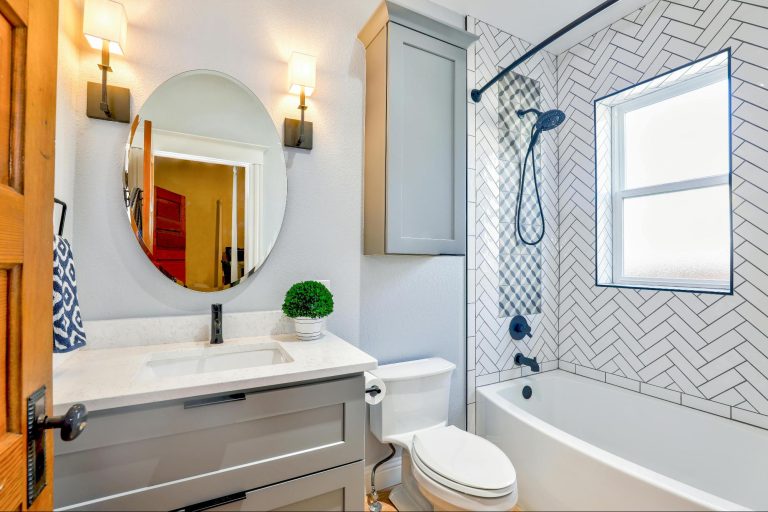Embarking on a bathroom DIY project can be an exhilarating blend of creativity and practicality. However, selecting durable materials is paramount to ensure that your creation stands the test of time.
A bathroom’s humid and wet environment demands materials that can resist moisture damage, mildew, and wear.
This guide will navigate you through the essentials of choosing materials that not only look beautiful but are also capable of withstanding the unique challenges of a bathroom setting.
Understand Your Bathroom’s Unique Needs
Every bathroom has its peculiarities. Evaluating the level of moisture exposure and traffic your bathroom will encounter is the first step. High moisture areas like showers and floors require materials with excellent water resistance, while vanity tops can afford to be slightly less hardy.
Tile: A Time-Tested Choice
Tile has been a go-to for bathrooms for decades. Not all tiles are created equal, though. Porcelain and ceramic tiles excel in moisture-prone areas due to their low porosity. But remember, the grade and thickness of the tile contribute significantly to its longevity.
For those contemplating a modern and elegant shower space, incorporating a large format tile shower can offer a seamless and expansive look, enhancing the aesthetic while ensuring durability in wet environments. The specific guide linked offers valuable insights into the advantages and considerations of using large format tiles, making it a worthwhile read for anyone looking to update their shower.
Metal Accents: A Touch of Sophistication
Metal fixtures and accents can introduce a sophisticated touch to any bathroom. Stainless steel, brass, and copper are not only resistant to corrosion but can also add a distinct style quotient to your space. The key is to ensure that they are properly treated to withstand the humid bathroom environment.
Engineered Stone: Resilience Redefined
For countertops, engineered stone offers an unparalleled blend of durability and aesthetic versatility. Composed of quartz and resin, it’s virtually impervious to stains and scratches, making it an ideal choice for high-use areas.
Paint and Finishes: Seal in Style
To complement your durable materials, the right paint and finishes are critical. Opt for high-quality, moisture-resistant paints designed for bathrooms. These can help prevent mold and mildew growth, ensuring your bathroom’s beauty lasts longer.
Natural Stone: Elegantly Enduring
If you’re inclined towards the natural beauty of stone, consider granite or slate for areas less exposed to water. Their natural resilience to scratches and aesthetic appeal make them a coveted choice for vanity tops and accents.
Maintenance: The Key to Longevity
No material, regardless of its inherent durability, will last without proper care and maintenance. Regular cleaning with appropriate products, immediate attention to leaks, and periodic resealing of surfaces as needed will help maintain your bathroom’s integrity and beauty. When selecting materials, consider their maintenance needs alongside their aesthetics and durability to ensure a lasting investment.
Wood: Warmth with a Word of Caution
Incorporating wood into a bathroom design adds warmth and natural beauty. Yet, it’s crucial to choose woods that are naturally resistant to moisture like teak or cedar. These materials can offer durability if properly sealed and maintained. However, they may require more upkeep than other materials.
Waterproof Membranes: The Unsung Heroes
Beneath the surface materials, waterproof membranes play a crucial role in protecting your bathroom from water damage. These hidden layers ensure that water does not seep into the structure of your home, guarding against rot and mold.
When planning your DIY project, paying attention to this unseen but vital component can save you from future headaches.
Lighting: Illuminate Your Space Wisely
Choosing the right lighting for your bathroom not only enhances its aesthetic but also contributes to the durability of the materials you select.
Moisture-resistant lighting fixtures can prevent rust and damage, while well-placed lights can reduce the risk of moisture buildup by promoting quick drying. Consider LED options for their longevity and energy efficiency.
Conclusion
Selecting the right materials for your bathroom DIY project doesn’t just add to the aesthetic appeal; it ensures longevity and durability.
While the quest for the perfect materials may seem daunting, understanding your space’s specific needs and the unique properties of each material can make the selection process exciting and fulfilling.
Remember, the best material choices are those that balance the practical needs of a bathroom with the style you seek to achieve. Dive into your project with confidence, knowing that the right materials can create a space that is as enduring as it is beautiful.

